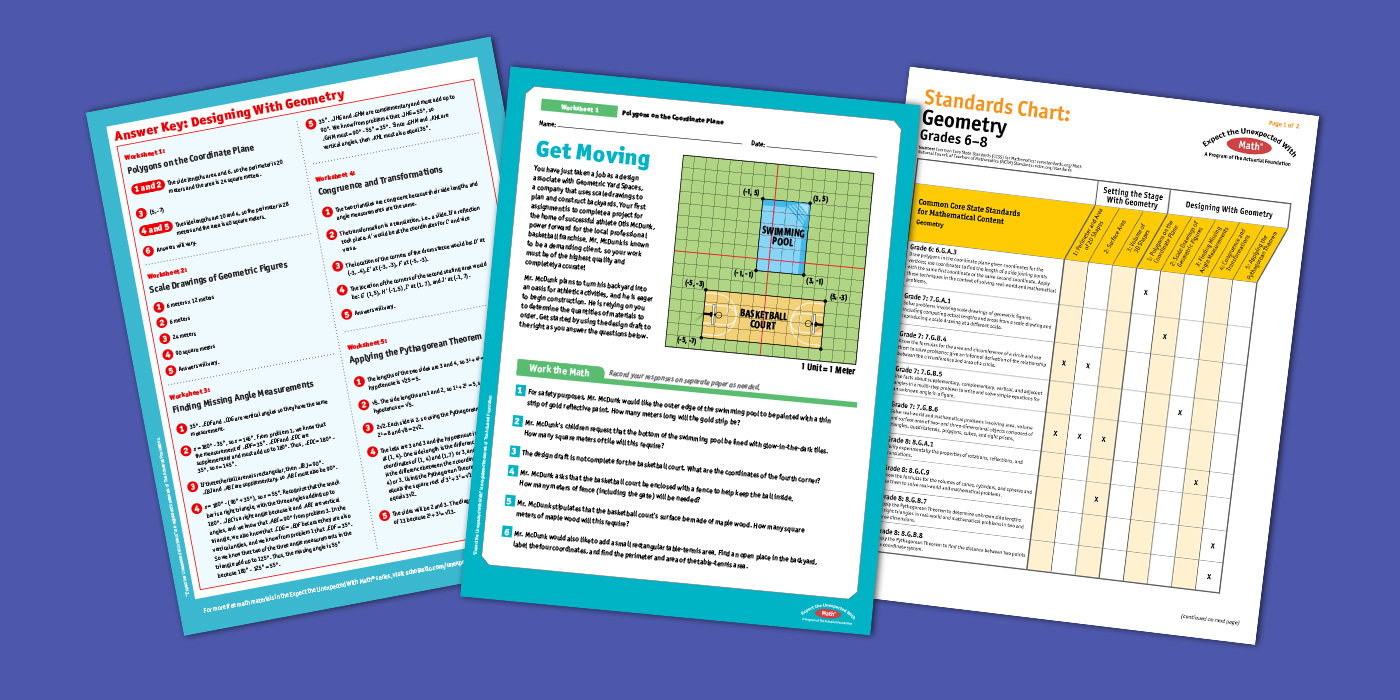Geometry Lesson Plan: Measuring Polygons on the Coordinate Plane
In this lesson plan, students will calculate length, perimeter, and area, as well as find missing coordinates and more.
Preinstructional Planning
Objectives
Students will:
- Draw polygons on the coordinate plane when given the coordinates
- Find the length of a polygon's sides drawn on the coordinate plane
- Find the area and perimeter of polygons drawn on the coordinate plane
- Find the "missing" coordinate when given three of the coordinates for a rectangle
- Use these concepts to calculate distance on a map
Materials
- Get Moving: Polygons on the Coordinate Plane printable
- Answer Key: Designing With Geometry printable
- Standards Chart: Geometry printable
- Graph paper
- Whiteboard or large graph paper and markers
During Instruction
Set Up
1. Make a class set of the Get Moving: Polygons on the Coordinate Plane printable.
2. Print a copy of the Answer Key: Designing With Geometry printable for your use.
Lesson Directions
Introduction to Polygons on the Coordinate Plane
Step 1: If necessary, review key concepts pertaining to the coordinate plane including how the (x, y) structure works (students sometimes have difficulty remembering that the x-coordinate comes first), and the quadrant system. Make sure that students know how to locate points with one or two negative numbers as coordinates.
Step 2: On the board, write the points (-2, -3), (4, -3), (4, 4), and (-2, 4). Plot these points on a coordinate grid. Ask what shape the points would make if connected (rectangle). Ask the class to provide a definition of a rectangle (four interior right angles and opposite sides are parallel and equal in length). Connect the points to make the rectangle.
Step 3: Ask the class how we know the opposite sides are equal in length. Demonstrate this to the class. In this case, the points (-2, 4) and (-2, -3) have the same x-coordinate (-2). To find the length, Subtract the two y coordinates: 4 - (-3) = 7, so the side has a length of 7 units. If the class needs a refresher in how to subtract negative numbers, do so at this point in the lesson.
Repeat with the opposite side (4, 4) and (4, -3) and show how the side length is also 7 units. Wrap up by showing that the other pair of opposite sides is 6 units per side.
Step 4: Ask the class to determine the perimeter of the rectangle (26 units = 7 + 7 + 6 + 6). If necessary, review the formula for perimeter and ensure that students know that a square is also a rectangle.
Step 5: Ask the class to determine the area of the rectangle (42 square units = 7 x 6). If necessary, review the formula for area.
Step 6: Draw the following three coordinates on the board: (-2, 0), (3, 0), and (3, 4). Ask, "If we wanted to draw a rectangle, what would the coordinates be for the fourth corner?" Show how the length of the bottom side is 5 (3 — -2), and the right side is 4 (4 — 0). That means that the x-coordinate of the missing corner is -2 (3 — 5) and the y coordinate is 4 (0 + 4).
Guided Practice
Step 7: Draw the following coordinates on the board: (-2, -1), (1, -1), and (1, 4). Assign the following problems for students to complete in pairs while discussing their thinking:
1. Find the coordinates of the point that would make a rectangle. Answer: (-2, 4)
2. Find the perimeter of the rectangle. Answer: 16 units = 2 x (3 + 5)
3. Find the area of the rectangle. Answer: 15 square units = 3 x 5
Step 8: Checking for Understanding: Review answers as a class and respond to any questions.
Independent Practice
Step 9: Assign the Get Moving: Polygons on the Coordinate Plane printable for classwork or homework.
Step 10: Checking for Understanding: Review the answers to the Get Moving: Polygons on the Coordinate Plane printable, which are provided on page 1 of the Answer Key: Designing With Geometry printable. Make sure students explain their mathematical thinking. Address any misconceptions that may arise.
Post Instructional
Standards
- Grade 6: Polygons on the Coordinate Plane (CCSS 6.G.3)
- Grades 6–8: Making Sense of Problems, Reasoning, Constructing an Argument, and Attending to Precision (CCSS MP1-3, and 6); NCTM Geometry
For more information, download the comprehensive Standards Chart: Geometry printable.



